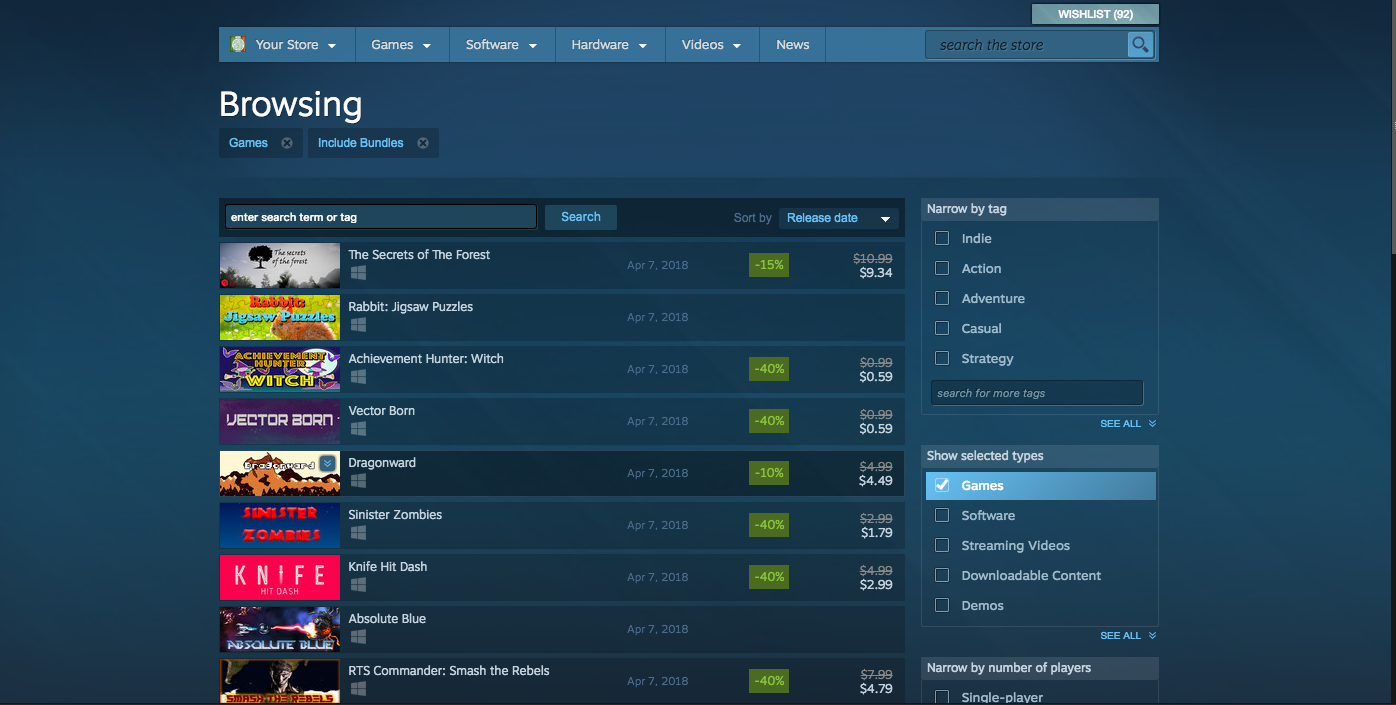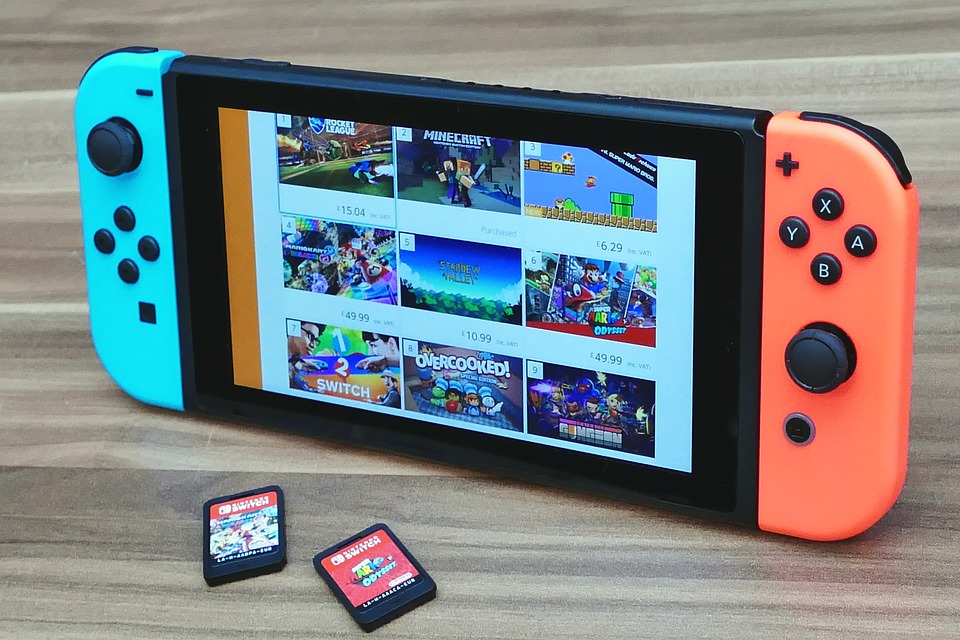As of this writing, in the middle of the afternoon on March 26th, 2018, there have been over 40 games released on the Steam platform today. Just today. This is a Monday, not a day for new releases (those are usually Tuesdays), and not a particularly busy time of year. How many of those 40 games are worth purchasing? What are they like? What are they about? Are there any hidden gems in there? Unfortunately, answering any of these questions, let alone all of them, would be quite a task, as again, this is just a Monday. That is not to say Steam gives you no information — they do. A hover of the mouse over the title gives you broad “genre” information, an overall review score, and whatever screenshots or videos the publisher decides to include. Is this enough? Is this enough to give the consumer confidence in parting with their hard-earned money? Yes, there are refunds available, of course — a welcome change and, in this author’s opinion, a needed one.
Many have written or made videos on this, pointing out some of the absurd content that gets put up on Steam by those either hoping for unwary shoppers, money laundering perhaps, or maybe content by a creator that truly does believe that their work is worthy of distribution. Steam Direct has democratized game creation, allowing some fantastic content to be distributed that might otherwise never have been seen. The influx of high-quality indie games that have come out in the past decade may never have made it to market before, and that is something truly special that we as gamers and in the gaming community should celebrate and encourage. But will the next great title get buried? Has it? Does the cream always rise to the top? Or does it get overwhelmed in the sludge and never see the light of day?
An average day of releases on the Steam Store …
Unfortunately, the answer may not be positive to these questions. There are currently over 22,000 games on Steam; in contrast, there were roughly 700 games released for the NES in North America, and roughly 1,700 games were released on Playstation 4. Good, right? Or not? This is where curation and discovery come into play.
Discovery
First, let’s start with discovery. Discovery is just what it sounds like, and we are probably all familiar with it. It is about finding something new. We do this in our lives in a wide variety of ways: trial and error, browsing, advertising, appearance, title, genre — we all have our own magic mix we look for when making choices from a vast catalog. We are used to doing this in libraries, stores, and when car shopping. All of these institutions have various ways of curating their collection of products or services to encourage you towards certain selections. Perhaps a manufacturer has paid to have their item have prime store placement (there is an entire industry built around customer behavior in retail environments and on websites). Perhaps the staff at a local library (like myself) have built a display of lesser-used items we want to see circulate out of the building and get read. The possibilities are endless.
How does Steam do this? Well, it relies on pushing content at you. Pushed content is content you don’t search for yourself, and in the era of ad impressions and the deluge of information the internet has created, pushing content is often the only way to get someone to see content; our time is limited, after all. Valve uses secretive algorithms to give you games it thinks you want. This can have mixed results. With dozens of games released a day, the ability to search by, say, genre, or to have that be a limiter to what you want to see is basically useless, as is looking simply at new content.
Instead of the careful curation that exists in physical storefronts or a library, Valve has decided to take a quasi-laissez faire approach, letting the community take the reins in discovery. On paper, and sometimes in practice, this sounds great. It’s a further democratization of art. In reality, this can often lead to very real problems.
Greenlight and Direct
Valve first tried this with the now-shuttered “Greenlight” system. Greenlight had users vote on games in development (some closer to a “pitch” than anything) that would appear on the platform. Enough votes and you were in. This led to some gems emerging, but also to some drek or broken promises, angering gamers. Steam shut down Greenlight in 2017 and is now relying on community curation and “Steam Direct.” Steam Direct essentially opens the floodgates to content and relies on the curators (publications, groups, and personalities) to sift through and make lists and recommendations. This is great for Valve as it can only cut costs and leaves the hard work to essentially unpaid volunteers. While Valve claims to verify that games going through Direct are vetted by them (vaguely promising the title is “configured correctly, matches the description provided on the store page, and doesn’t contain malicious content”), they offer no explanation of what “malicious” means in regard to content.
While relying on these curators, the way you search for these curators is frankly a hot mess. Steam will “recommend” curators (again, no explanations as to why these curators are being pushed at you), give you a list of “top” curators, which is a solid option, or allow you to search. Much like the game searching, there is just way, way too much here. You have to click through dozens of profiles of avatars to find quality curators whose tastes, values, and standards might align with yours, or at least complement them. Many of these don’t seem to be active to boot, and even more seem inconsistent, which is understandable given the lack of reimbursement.
Steam’s lack of oversight has also led to it being full of hate groups and bile. This is a potential nightmare for Valve, as brigading, mass voting, and trolling are inevitable based on any reading of recent internet history.
Where this does succeed, however, is in making Valve massive amounts of money. It is doing better than ever. As long as this is happening and Gabe Newell can strive to be a niche version of Jeff Bezos, it is not going to change. What is the cost? A platform that is safe and welcoming for new players, those turned off by the cesspool that seeps throughout the internet wherever gaming meets Slack moderation, and an increasing number of developers who are increasingly looking at other platforms for their games, platforms like GOG and the Nintendo Switch. Valve’s gatekeeping is failing at making them a “no rules” platform for small, honest developers, while at the same time, their tolerance for poor behavior is causing them to fail at being a safe, comfortable place for all as well.

 Order, not chaos
Order, not chaos





Published: Apr 1, 2018 07:00 pm